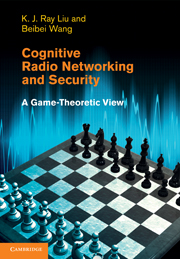Book contents
- Frontmatter
- Contents
- Preface
- Part I Cognitive radio communications and cooperation
- 1 Introduction to cognitive radios
- 2 Game theory for cognitive radio networks
- 3 Markov models for dynamic spectrum allocation
- 4 Repeated open spectrum sharing games
- 5 Pricing games for dynamic spectrum allocation
- 6 A multi-winner cognitive spectrum auction game
- 7 Evolutionary cooperative spectrum sensing games
- 8 Anti-jamming stochastic games
- 9 Opportunistic multiple access for cognitive networks
- Part II Resource awareness and learning
- Part III Securing mechanism and strategies
- References
- Index
3 - Markov models for dynamic spectrum allocation
from Part I - Cognitive radio communications and cooperation
Published online by Cambridge University Press: 06 December 2010
- Frontmatter
- Contents
- Preface
- Part I Cognitive radio communications and cooperation
- 1 Introduction to cognitive radios
- 2 Game theory for cognitive radio networks
- 3 Markov models for dynamic spectrum allocation
- 4 Repeated open spectrum sharing games
- 5 Pricing games for dynamic spectrum allocation
- 6 A multi-winner cognitive spectrum auction game
- 7 Evolutionary cooperative spectrum sensing games
- 8 Anti-jamming stochastic games
- 9 Opportunistic multiple access for cognitive networks
- Part II Resource awareness and learning
- Part III Securing mechanism and strategies
- References
- Index
Summary
In a dynamically changing spectrum environment, it is very important to consider the statistics of different users' spectrum access so as to achieve more efficient spectrum allocation. In this chapter, we study a primary-prioritized Markov approach for dynamic spectrum access through modeling the interactions between the primary and the secondary users as continuous-time Markov chains (CTMCs). Using the CTMC models, to compensate for the throughput degradation due to the interference among secondary users, we derive the optimal access probabilities for the secondary users, by which means the spectrum access of the secondary users is optimally coordinated and the spectrum dynamics clearly captured. Therefore, a good tradeoff between the spectrum efficiency and fairness can be achieved. The simulation results show that the primary-prioritized dynamic spectrum access approach under the criterion of proportional fairness achieves much higher throughput than do the CSMA-based random access approaches and the approach achieving max–min fairness. Moreover, it provides fair spectrum sharing among secondary users with only small performance degradation compared to the approach maximizing the overall average throughput.
Introduction
Efficiently and fairly sharing the spectrum among secondary users in order to fully utilize the limited spectrum resources is an important issue, especially when multiple dissimilar secondary users coexist in the same portion of the spectrum band. Although existing dynamic spectrum access schemes have successfully enhanced spectrum efficiency, most of them focus on spectrum allocation among secondary users in a static spectrum environment.
Information
- Type
- Chapter
- Information
- Cognitive Radio Networking and SecurityA Game-Theoretic View, pp. 87 - 110Publisher: Cambridge University PressPrint publication year: 2010
